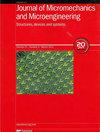A liquid-metal-based microscale calorimetric in-chip flow sensor for flow rate measuring
IF 2.1
4区 工程技术
Q2 ENGINEERING, ELECTRICAL & ELECTRONIC
引用次数: 0
Abstract
This work proposes a liquid-metal-based calorimetric micro-flow sensor within a polydimethylsiloxane (PDMS) chip. It can measure the flow rate of fluid in microscale channels, with a range as low as several microliters per minute. This in-chip sensor is proposed to solve the issue of detecting the flow rate in microfluidic systems. To make the sensor compatible with PDMS microfluidic chips, low-melting-point gallium-based alloy and bismuth-based (bi-based) alloy are used to make the micro heater and bi-metal thermocouples, for these alloys can be easily injected into a PDMS chip to form electrodes. To minimize heat resistance (or temperature difference) between fluid and the detecting ends of thermocouples, these ends are directly exposed to liquid in the flow channel with the help of a special reversible bonding technology. Thermocouples are connected in parallel to improve the sensor’s response. A novel method to bond and electrically connect the sensor to a PCB (print circuit board) is also elaborated. Since the calorimetric flow sensor is sensitive to heating power, fluid temperature and environment cooling, a dimensionless parameter less independent of these factors is deduced from heat transfer theory, and this idea is used in result processing to offset the bad effect. Experiments with pure water show that this sensor can be used to detect flow rates, with a resolution up to 4 µl/min/mV and a range of 12 µl/min in this case, and that at different heating powers, the thermal potential results vary significantly whereas the dimensionless results nearly keep the same. Present work indicates that this sensor has the potential to be integrated into a PDMS microfluidic system and to provide accurate and stable results if a dimensionless method is used in data processing.用于测量流量的液态金属微尺度热量计片内流量传感器
这项研究提出了一种在聚二甲基硅氧烷(PDMS)芯片内的液态金属热量微流量传感器。它可以测量微米级通道中流体的流速,测量范围低至每分钟几微升。提出这种片内传感器是为了解决微流体系统中的流速检测问题。为了使传感器与 PDMS 微流控芯片兼容,使用了低熔点镓基合金和铋基(双基)合金来制作微加热器和双金属热电偶,因为这些合金可以很容易地注入 PDMS 芯片中形成电极。为了尽量减小流体与热电偶检测端之间的热阻(或温差),热电偶检测端借助特殊的可逆键合技术直接暴露在流道中的液体中。并联热电偶可提高传感器的响应速度。此外,还阐述了一种将传感器与印刷电路板(PCB)进行粘合和电气连接的新方法。由于热量流量传感器对加热功率、流体温度和环境温度敏感,因此从传热理论中推导出了一个与这些因素不太相关的无量纲参数,并将这一想法用于结果处理,以抵消不良影响。纯水实验表明,该传感器可用于检测流速,分辨率可达 4 µl/min/mV,量程为 12 µl/min。目前的工作表明,如果在数据处理中使用无量纲方法,该传感器有可能集成到 PDMS 微流控系统中,并提供准确、稳定的结果。
本文章由计算机程序翻译,如有差异,请以英文原文为准。
求助全文
约1分钟内获得全文
求助全文
来源期刊

Journal of Micromechanics and Microengineering
工程技术-材料科学:综合
CiteScore
4.50
自引率
4.30%
发文量
136
审稿时长
2.8 months
期刊介绍:
Journal of Micromechanics and Microengineering (JMM) primarily covers experimental work, however relevant modelling papers are considered where supported by experimental data.
The journal is focussed on all aspects of:
-nano- and micro- mechanical systems
-nano- and micro- electomechanical systems
-nano- and micro- electrical and mechatronic systems
-nano- and micro- engineering
-nano- and micro- scale science
Please note that we do not publish materials papers with no obvious application or link to nano- or micro-engineering.
Below are some examples of the topics that are included within the scope of the journal:
-MEMS and NEMS:
Including sensors, optical MEMS/NEMS, RF MEMS/NEMS, etc.
-Fabrication techniques and manufacturing:
Including micromachining, etching, lithography, deposition, patterning, self-assembly, 3d printing, inkjet printing.
-Packaging and Integration technologies.
-Materials, testing, and reliability.
-Micro- and nano-fluidics:
Including optofluidics, acoustofluidics, droplets, microreactors, organ-on-a-chip.
-Lab-on-a-chip and micro- and nano-total analysis systems.
-Biomedical systems and devices:
Including bio MEMS, biosensors, assays, organ-on-a-chip, drug delivery, cells, biointerfaces.
-Energy and power:
Including power MEMS/NEMS, energy harvesters, actuators, microbatteries.
-Electronics:
Including flexible electronics, wearable electronics, interface electronics.
-Optical systems.
-Robotics.
 求助内容:
求助内容: 应助结果提醒方式:
应助结果提醒方式:


